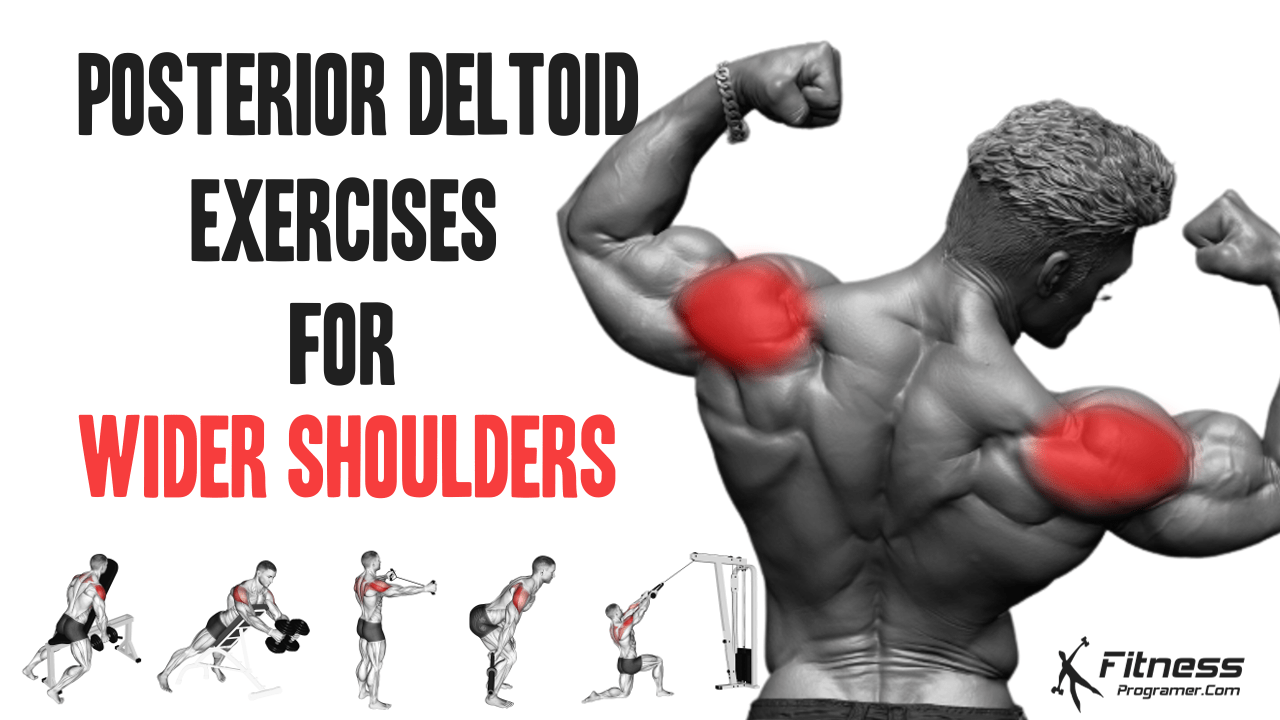Contents
A comprehensive shoulder workout should address all three heads of the deltoid muscles – anterior, lateral, and posterior – to ensure balanced muscle development and joint integrity. By targeting the posterior deltoids, you can enhance the overall aesthetics of your shoulders and boost performance in various activities, from lifting weights to performing daily tasks.
In this article, we’ll highlight some of the most effective posterior deltoid exercises that you can incorporate into your workout routine. Whether you’re aiming to build mass, improve shoulder definition, or enhance functional strength, these exercises will help you achieve your fitness goals while promoting shoulder health and resilience.
Posterior Deltoid Anatomy
The posterior deltoid, located at the back of the shoulder, is one of the three main muscles that make up the shoulder muscle group. They originate from the spine of the scapula (shoulder blade) and insert into the humerus (upper arm bone), forming a triangular shape that contributes to the rounded contour of the shoulder.
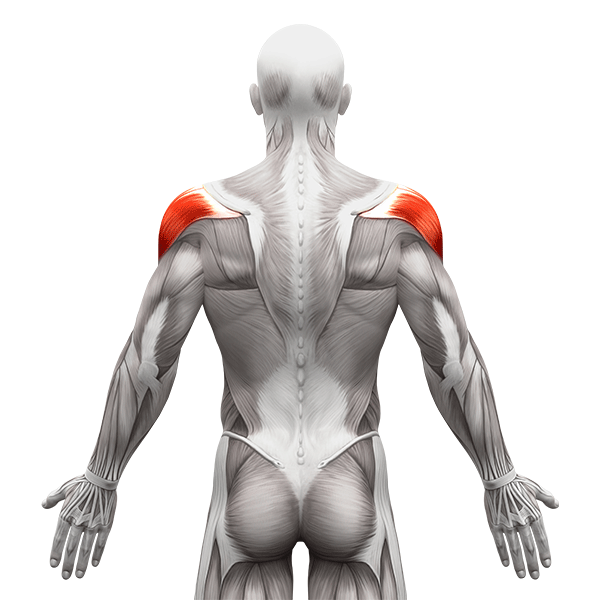
Function: What is the action of the posterior deltoid?
It is important to know shoulder joint movements for general shoulder health.
The primary function of the posterior deltoid muscles is to facilitate shoulder extension, which involves moving the arm backward from a forward position. It plays an important role in shoulder movement and stabilization. Additionally, they assist in horizontal abduction, which is the movement of the arm away from the midline of the body while keeping it parallel to the ground. The posterior deltoids also play a role in external rotation of the shoulder joint.
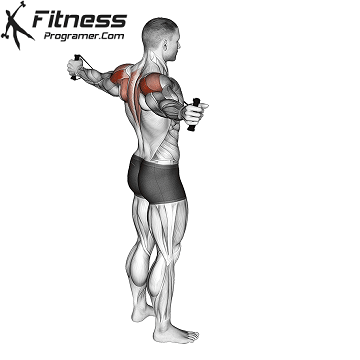

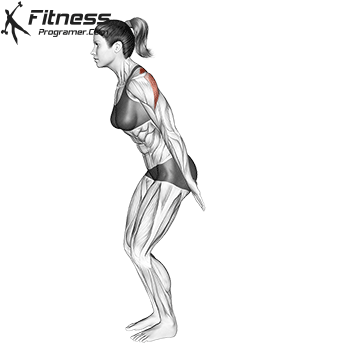
What is the importance of the posterior deltoid?
Here are some reasons why your posterior deltoids matter and how to train them properly:
1. Improved Posture: Strong posterior deltoids help to improve your posture by supporting the upper back and pulling your shoulders back. This helps to prevent rounded shoulders, which can lead to poor posture and back pain.
2. Reduced Risk of Injuries: Your posterior deltoids play a crucial role in shoulder stabilization, which helps to reduce the risk of shoulder injuries, especially during sports and other physical activities. (Learn the importance of rotator cuff exercises to optimize injury risk.)
3. Enhanced Athletic Performance: Strong posterior deltoids contribute to better shoulder mobility, which is essential for many athletic activities, including throwing, lifting, and pushing. Additionally, stronger posterior deltoids improve your overall shoulder strength, which can enhance your athletic performance.
4. Required for Wide Shoulders: The muscles responsible for creating the appearance of wide shoulders are the deltoids as a whole, which includes the anterior (front), medial (middle), and posterior (back) heads. While it is not the primary muscle responsible for creating the appearance of wide shoulders, it does play a role in overall shoulder development and width.
Now that you understand the importance of your rear deltoids, here are some exercises on how to train them properly.
What exercises targets the posterior deltoid?
Incorporating posterior deltoid exercises into your shoulder workout routine can help to build wider shoulders and improve overall upper body strength and aesthetics. By prioritizing these exercises, warming up properly, choosing the right exercises, varying your training angles, using proper form, and using progressive overload, you can maximize the effectiveness of your shoulder workout and achieve your training goals.
Here are some examples of effective posterior deltoid exercises:
1- Cable Rear Delt Fly
Cable rear delt fly is an effective exercise that targets the posterior deltoid muscles, which are located on the back of the shoulders. It also targets the upper back muscles, including the rhomboids and trapezius. It can be performed by people of all fitness levels, and can be easily modified to suit individual needs and preferences.
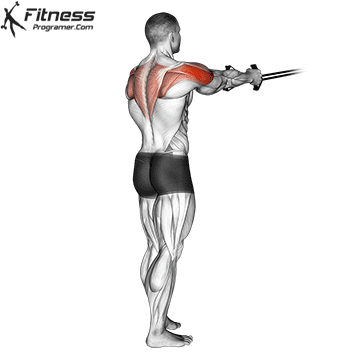
- To do this exercise on a cable machine or with a resistance band, stand facing the machine with your feet shoulder-width apart and your hands at shoulder level.
- Hold the cable attachment with both hands, palms facing in towards each other, and step back until there is tension on the cable.
- Keep your arms straight but don’t lock, pull the cable attachment back, squeezing your shoulder blades at the top of the movement.
- Hold the contraction for a second or two, then slowly release the cable back to the starting position.
2- Bent-over reverse cable fly
Bent-over reverse cable fly is an exercise that targets the posterior deltoid muscles, as well as the muscles of the upper back. You can do this exercise with a dumbbell or resistance band.
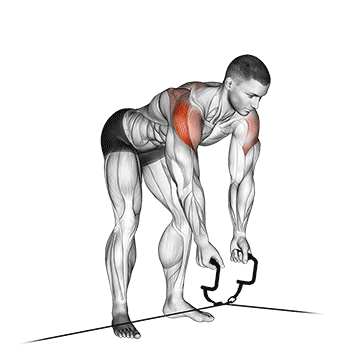
Here’s how to perform this exercise:
- Stand facing away from the machine, with your feet shoulder-width apart and a slight bend in your knees.
- Keep your arm straight and your elbow slightly bent.
- Lean forward, keeping your back straight, and your torso parallel to the floor.
- Keeping your elbow slightly bent, lift your arm out to the side and up towards your shoulder. Focus on squeezing your shoulder blade and contracting your posterior deltoid muscle as you lift.
- Lower your arm back down towards the cable machine, keeping it straight but not locked out.
- Repeat for the desired number of reps, then switch sides and repeat with the other arm.
3- Barbell Reverse Raise
This exercise is an effective way to target the often neglected posterior deltoid muscles. Since the direction of the movement is backwards, it is recommended to do this exercise with a light weight instead of lifting heavy.
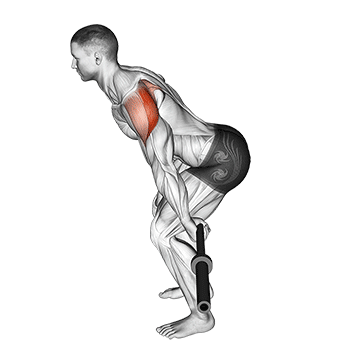
Here’s how to perform this exercise:
- Stand with your feet shoulder-width apart, holding a barbell with an overhand grip. Your hands should be slightly wider than shoulder-width apart.
- Keeping your back straight, lean your body slightly forward.
- Keeping your elbows slightly bent, lift the barbell up and out to the sides, until your arms are parallel to the ground. Focus on squeezing your shoulder blades and contracting your posterior deltoid muscles as you lift.
4- Half Kneeling High Cable Row
Half kneeling high cable row with rope is a compound exercise that primarily targets the upper back muscles, including the posterior deltoids. Start with a lighter weight and gradually increase as you become more comfortable with the movement. You can also perform this exercise standing up instead of kneeling, if preferred.
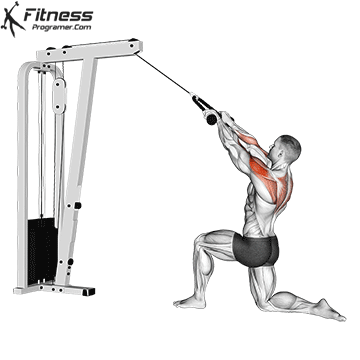
Here’s how to perform this exercise:
- Set up a cable machine with a rope attachment at the highest height setting. Kneel down on one knee facing the machine, with the other foot planted firmly on the ground in front of you.
- Grab the rope with both hands, palms facing in towards each other. Keep your arms straight, but not locked out.
- Engage your core and pull the rope towards your body, bending your elbows and squeezing your shoulder blades together as you bring the rope towards your chest.
- Hold the contraction for a second or two, then slowly release the rope back to the starting position, keeping your arms straight but not locked out. Repeat for the desired number of reps.
5- 45 Degree Incline Dumbbell Row
The 45 degree incline row is an effective compound exercise that primarily targets the upper back muscles, including the posterior deltoids. You can also do this exercise with a barbell instead of dumbbells, depending on your preference.
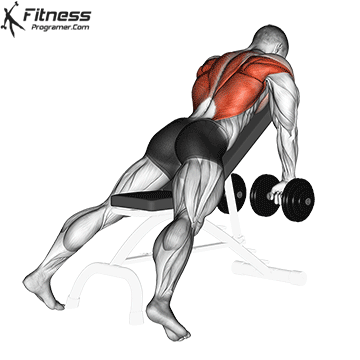
Here’s how to perform this exercise:
- Set up an incline bench at a 45 degree angle. Stand facing the bench, with your feet shoulder-width apart and your knees slightly bent. Hold a pair of dumbbells with an overhand grip.
- Bend forward at the hips, keeping your back straight and your core engaged.
- Keeping your elbows close to your body, pull the dumbbells up towards your chest, squeezing your shoulder blades together at the top of the movement.
- Hold the contraction for a second or two, then slowly lower the dumbbells back down to the starting position.
6- Lying one-arm rear lateral raise
This exercise is an isolation exercise that targets the posterior deltoid muscles. Incorporating dumbbell lying one-arm rear lateral raises into your workout routine can help you to isolate and develop your posterior deltoids, leading to stronger, more defined shoulders.

Here’s how to perform this exercise:
- Lie on your stomach on a flat bench with a dumbbell in one hand. Your arm should be extended down towards the floor.
- Keeping your arm straight, slowly raise the dumbbell to the side until it reaches shoulder height. Your palm should be facing downwards.
- Hold the dumbbell at the top of the movement for a second, then slowly lower it back to the starting position.
- Repeat for the desired number of repetitions before switching to the other arm.
7- Chest Supported Lateral Raise
Chest supported lateral raises are an isolation exercise that primarily targets the lateral and posterior deltoid muscles, as well as the muscles of the upper back. It’s important to keep your chest and stomach pressed firmly against the bench throughout the exercise to avoid injury and maximize the benefits to your posterior deltoid muscles. Start with a lighter weight and gradually increase as you become more comfortable with the movement.
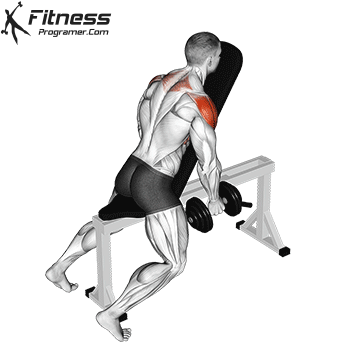
Here’s how to perform this exercise:
- Lie face down on an incline bench with your chest and stomach against the bench, holding a pair of dumbbells with an overhand grip.
- Let your arms hang straight down towards the floor, with your palms facing each other.
- Keeping your elbows slightly bent, lift the dumbbells up and out to the sides until they are parallel to the ground.
- Hold the contraction for a second or two, then slowly lower the dumbbells back down to the starting position.
8- Dumbbell rear delt raise with head on bench
Another effective exercise that isolates the posterior deltoid. Use a weight that is appropriate for your strength level, and avoid using momentum to lift the weights. Keep your core engaged and your back straight throughout the exercise, and avoid arching your back or letting your shoulders hunch up towards your ears.
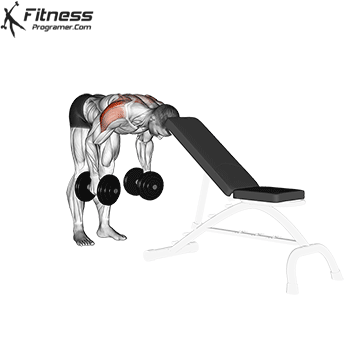
Here’s how to perform this exercise:
- Bend your knees slightly and hinge forward at your hips, keeping your back straight and your head down. Place your forehead on the bench and keep your arms hanging straight down with the dumbbells in your hands.
- Engage your shoulder blades and raise the dumbbells straight out to the sides, with your elbows slightly bent, until your arms are parallel with the ground.
- Hold this position for a moment, then slowly lower the weights back down to the starting position.
- Repeat for the desired number of repetitions.
9- Barbell rear delt raise
The barbell rear delt raise is a great posterior deltoid exercise that can help to build wider shoulders. Use a light weight to start, as this exercise can be challenging for the posterior deltoids. Focus on leading with your elbows, rather than pulling with your hands, to ensure that you are targeting the posterior deltoids effectively.
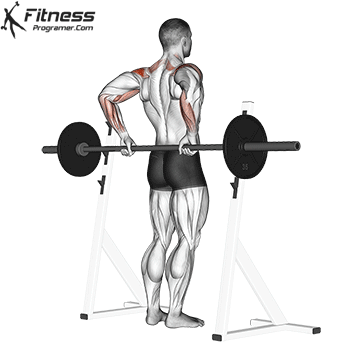
Here’s how to perform this exercise:
- Begin by standing with your feet shoulder-width apart and holding a barbell with an overhand grip behind your thighs. Your hands should be shoulder-width apart.
- Keep your back straight, your shoulders down and back, and your elbows slightly bent. This will be your starting position.
- Slowly raise the barbell, keeping your elbows close to your sides.
- Hold the top position for a second, then slowly lower the barbell back down to the starting position.
10- Y-Raise
The Y-raise is a posterior deltoid exercise that targets the upper back and shoulders. Keep your neck in a neutral position, avoiding any strain on your neck and upper traps. Use a light weight to start, as this exercise can be challenging for the posterior deltoids. Keep the movement slow and controlled, avoiding any jerky or swinging motions.

Here’s how to perform this exercise:
- Lie face down on a bench with your chest and stomach supported, and your feet firmly planted on the ground.
- Hold a pair of light dumbbells in your hands with your palms facing the floor.
- Keeping your arms straight, lift the dumbbells off the ground, and raise them up and out to the sides of your body, forming a Y-shape with your arms.
- Pause briefly at the top of the movement, then slowly lower the dumbbells back down to the starting position.
- Repeat for your desired number of repetitions.
The Bottom Line
The posterior deltoid helps to create a well-rounded and balanced look to the shoulders, which can contribute to the appearance of width. However, it is important to note that genetics also play a role in determining the width of your shoulders, and simply training the posterior deltoids alone will not drastically change the overall width of your shoulders. A well-rounded training program that includes exercises targeting all three heads of the deltoids, along with other shoulder and upper body muscles, can help improve overall shoulder width and appearance.

